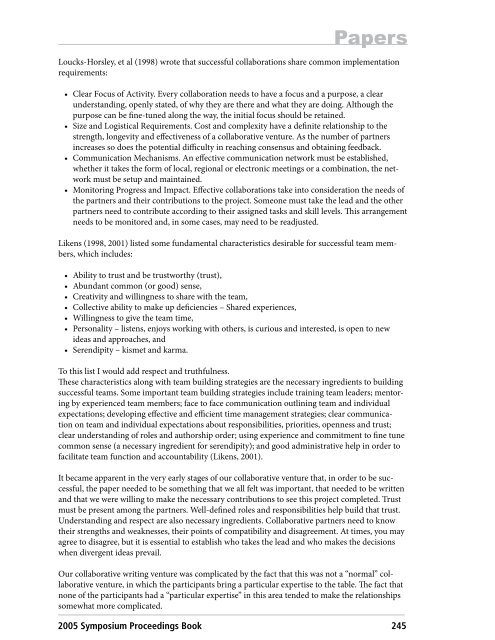The SRA Symposium - College of Medicine
The SRA Symposium - College of Medicine
The SRA Symposium - College of Medicine
You also want an ePaper? Increase the reach of your titles
YUMPU automatically turns print PDFs into web optimized ePapers that Google loves.
Papers<br />
Loucks-Horsley, et al (1998) wrote that successful collaborations share common implementation<br />
requirements:<br />
• Clear Focus <strong>of</strong> Activity. Every collaboration needs to have a focus and a purpose, a clear<br />
understanding, openly stated, <strong>of</strong> why they are there and what they are doing. Although the<br />
purpose can be fine-tuned along the way, the initial focus should be retained.<br />
• Size and Logistical Requirements. Cost and complexity have a definite relationship to the<br />
strength, longevity and effectiveness <strong>of</strong> a collaborative venture. As the number <strong>of</strong> partners<br />
increases so does the potential difficulty in reaching consensus and obtaining feedback.<br />
• Communication Mechanisms. An effective communication network must be established,<br />
whether it takes the form <strong>of</strong> local, regional or electronic meetings or a combination, the network<br />
must be setup and maintained.<br />
• Monitoring Progress and Impact. Effective collaborations take into consideration the needs <strong>of</strong><br />
the partners and their contributions to the project. Someone must take the lead and the other<br />
partners need to contribute according to their assigned tasks and skill levels. This arrangement<br />
needs to be monitored and, in some cases, may need to be readjusted.<br />
Likens (1998, 2001) listed some fundamental characteristics desirable for successful team members,<br />
which includes:<br />
• Ability to trust and be trustworthy (trust),<br />
• Abundant common (or good) sense,<br />
• Creativity and willingness to share with the team,<br />
• Collective ability to make up deficiencies – Shared experiences,<br />
• Willingness to give the team time,<br />
• Personality – listens, enjoys working with others, is curious and interested, is open to new<br />
ideas and approaches, and<br />
• Serendipity – kismet and karma.<br />
To this list I would add respect and truthfulness.<br />
<strong>The</strong>se characteristics along with team building strategies are the necessary ingredients to building<br />
successful teams. Some important team building strategies include training team leaders; mentoring<br />
by experienced team members; face to face communication outlining team and individual<br />
expectations; developing effective and efficient time management strategies; clear communication<br />
on team and individual expectations about responsibilities, priorities, openness and trust;<br />
clear understanding <strong>of</strong> roles and authorship order; using experience and commitment to fine tune<br />
common sense (a necessary ingredient for serendipity); and good administrative help in order to<br />
facilitate team function and accountability (Likens, 2001).<br />
It became apparent in the very early stages <strong>of</strong> our collaborative venture that, in order to be successful,<br />
the paper needed to be something that we all felt was important, that needed to be written<br />
and that we were willing to make the necessary contributions to see this project completed. Trust<br />
must be present among the partners. Well-defined roles and responsibilities help build that trust.<br />
Understanding and respect are also necessary ingredients. Collaborative partners need to know<br />
their strengths and weaknesses, their points <strong>of</strong> compatibility and disagreement. At times, you may<br />
agree to disagree, but it is essential to establish who takes the lead and who makes the decisions<br />
when divergent ideas prevail.<br />
Our collaborative writing venture was complicated by the fact that this was not a “normal” collaborative<br />
venture, in which the participants bring a particular expertise to the table. <strong>The</strong> fact that<br />
none <strong>of</strong> the participants had a “particular expertise” in this area tended to make the relationships<br />
somewhat more complicated.<br />
2005 <strong>Symposium</strong> Proceedings Book 245

















